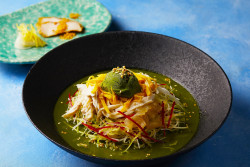
Over the past year, hip-hop has become increasingly popular in Japan. Thanks to a wave of young MCs and, more importantly, the popularity of shows such as Freestyle Dungeon (imagine 8 Mile as a game show), rap is getting a lot of attention across the country.
“Freestyle hip-hop is experiencing a boom right now. I think it is good to have this entry point, for people who didn’t know about hip-hop,” says the artist STUTS, a 27-year-old beatmaker who fell for the style back during another wave of rap’s popularity, the early 2000s.
“But I also am worried people will stop there, and not go forward,” he explains. “I want to work to change that part.”
To that end, STUTS—who never reveals his name—shows that the beats rappers rhyme over can be compelling on their own. He’s become an in-demand producer and remixer for some of the nation’s best rappers, thanks to a sample-heavy approach in the same vein as American trackmakers such as Pete Rock and J Dilla—favorites of STUTS.
And he’s just as interested in letting the music shine by itself. Last spring, he released his first full-length album, Pushin’, which featured a few guest vocalists and MCs but was built primarily around a wide array of dusty samples and drum machine beats. It is an inviting and warm nod to the genre’s history that also shows how much depth beats can have on their own.
“With the album, it was my first chance to really make a body of work that totally satisfied myself, completely,” STUTS says from his label’s Shibuya office. “I learned how to make an album flow, and how to match everything with the artwork to make a total work.”
STUTS’ entry into hip-hop was thanks to Japanese outfit Rip Slyme and Detroit’s Eminem. Intrigued by the style, he dug deeper, falling for the likes of American cornerstones De La Soul and A Tribe Called Quest along with domestic beatmakers such as DJ Mitsu The Beats.
“The first year of high school, I bought an MPC player,” he recalls. “At first I wanted to make beats that I could rap over myself. But I realized creating the beats was the actual fun part for me, not rapping over them.”
Furthering his foray into rap, STUTS traveled to the United States on two occasions, stopping in Los Angeles and New York to soak up the musical atmosphere (he also studied computer science at university, so stays in San Francisco and Boston, for MIT, were also part of the trip). “I played my MPC on the street in New York,” he recalls. “Seeing people react to the beats I made, seeing them get excited about them…that was really exciting.”
Following his stateside stay, STUTS returned to Japan and started making beats for rappers, catching attention for his bouncy, sample-based creations. At the same time, he was uploading music online, slowly getting attention for his work. That led to Pushin’.
Rappers make appearances on his debut, and for those unfamiliar with the nation’s new generation of MCs, Pushin’ does offer a nice snapshot of the scene. Notable names such as Punpee, Kid Fresino and Campanella have verses. However, it also features appearances by singer Chiyori and indie-pop act Alfred Beach Sandal, a reflection of how STUTS sees music is changing.
“I also think the boundaries between genres are vanishing, and I only think genres are going to continue to influence one another in new ways.”
Still, the focus lately falls on STUTS himself. Since Pushin’ came out, he’s popped up on bills across the country, racked up YouTube views and gotten shout-outs from big-time J-Pop stars such as Gen Hoshino. The draw is his beatmaking. He reimagines all sorts of genres, plucking sounds from old records. “I like things that connect with me emotionally. Samples that are the essence of rap music—so jazz, soul, funk.”
This isn’t new. Sampling has been a central element of rap ever since it bubbled up decades ago. Yet in Japan, STUTS’ digging habits offer an interesting new wrinkle during the current hip-hop boom. Alongside more obscure finds, he samples many of his favorite rap artists, sometimes as intentional homages and other times as happy accidents. On Pushin’, for example, the familiar voice of A Tribe Called Quest’s Q-Tip pops up, as do echoes of songs constructed by J Dilla. One direct nod to the past comes via a snippet of drummer George Marsh talking about his instrument, which pops up across the album. It’s the same sample that appears early on in Bay Area producer DJ Shadow’s landmark album Endtroducing….., one of the most celebrated albums built from samples.
STUTS’ music connects the dots of hip-hop history, and offers a catchy gateway into the style for younger listeners who might just be getting interested in rap. With its funky horn stabs and boom-bap pace, it definitely sounds good—by itself or backing up a rhymer. But the music also shows the depth beneath.
Right now, STUTS is working on a new EP and, after that, an album, alongside a few live shows. And most likely a lot of digging for more sounds to share with a new generation of listeners.







